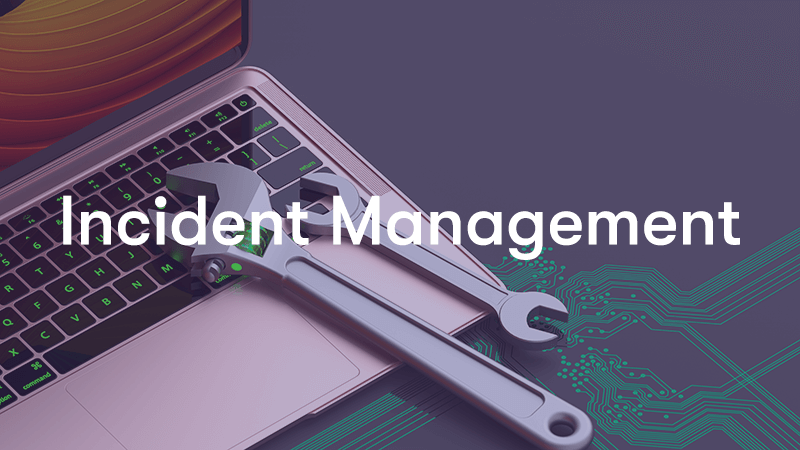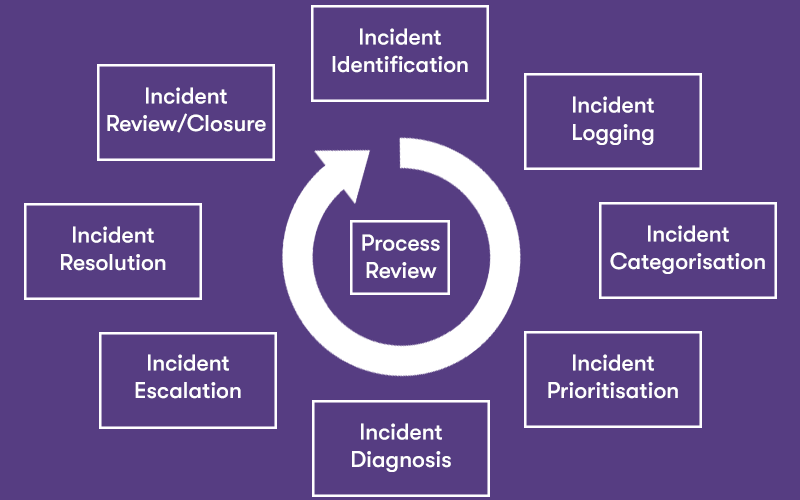ITIL® Incident Manager
ITIL Incident Manager is the person responsible for coordinating and managing the Incident Management process. Their main goal is to minimize the impact of incidents on the organisation and ensure that normal service is restored as soon as possible.
To achieve this, the Incident Manager must have a deep understanding of the Incident Management process and the IT services being supported. They must also be skilled in communication and collaboration, as they will be working closely with various stakeholders such as end-users, technical support teams, and management.
In this blog, I will dive deeper into the concepts related to ITIL Incident Management and the Incident Manager role. We will explore the key components of the Incident Management process, the skills required to be a successful ITIL Incident Manager, and the benefits of implementing Incident Management using the ITIL framework.
So, sit back and get ready to learn more about ITIL Incident Management and the critical role of the ITIL Incident Manager.
- What is the Definition of an Incident in ITIL?
- What is Incident Management in ITIL?
- What is the ITIL Incident Manager?
- What is the Difference Between Incident Management and Problem Management?
- What Are the Benefits of Incident Management?
- ITIL Processes Related to Incident Management
- Roles and Responsibilities Related to Incident Management
- Incident Management Best Practices
- Incident Management KPIs
- Final Notes On ITIL Incident Management
What is the Definition of an Incident in ITIL?
In ITIL, an incident is defined as an unplanned interruption or reduction in the quality of an IT service. It can also be an event that has not yet impacted the service, but there is a potential impact. Incidents can be caused by various factors, including hardware or software failures, network outages, cyber-attacks, or human errors.
What is Incident Management in ITIL?
ITIL incident management is the process of restoring normal service operation as quickly as possible after an IT service disruption, in order to minimise the impact on the organisation. It involves identifying, logging, categorising, prioritising, investigating, diagnosing, and resolving incidents.
The goal of incident management is to restore normal service operation as quickly as possible, minimise adverse impact on organisational operations, ensure quality of service, and maintain customer satisfaction. The incident management process is typically initiated by the detection of an event or by a user reporting an issue.
Once an incident has been reported, it is logged in a system called an Incident Management System (IMS), and in larger organisations this may be part of an integrated service management system supporting incident, change and problem management processes. It is then assigned a priority based on its business impact and urgency. The incident is then investigated and diagnosed to determine the underlying cause (which may require raising a problem record and assigning to problem management), and a resolution is identified and implemented. Throughout the incident management process, communication with stakeholders is critical to ensure that they are informed of the status of the incident and any actions being taken to resolve it.
Incident management is an essential component of IT service management, as it enables organisations to respond quickly and effectively to IT service disruptions, minimise their impact on the organisation, and maintain service quality and customer satisfaction.
What is the ITIL Incident Manager?

Incidents are an inevitable part of IT service delivery, and without a well-defined and structured incident management process, organizations may struggle to effectively respond to incidents and resolve them in a timely manner. This can lead to prolonged service disruptions, decreased customer satisfaction, and even financial losses.
ITIL incident management helps organisations to identify, prioritise, and manage incidents in a systematic and efficient manner. It provides a framework for quickly resolving incidents and returning services to normal operation, minimizing the impact on business operations and customers.
Effective incident management also requires strong communication and collaboration between IT teams and other stakeholders. By establishing clear roles and responsibilities, using effective tools and processes, and maintaining open lines of communication, organisations can ensure that incidents are effectively managed and resolved.
Overall, ITIL incident management is essential for maintaining high levels of service quality and availability, and for ensuring that customers receive the high-quality service they expect. By implementing best practices for incident management, organisations can minimise the impact of incidents on their business operations and ensure the ongoing success of their IT services.
What is the Difference Between Incident Management and Problem Management?
Incident management and problem management are two critical processes within the ITIL 4 framework. Incident management is a reactive process, while problem management is both a reactive and a proactive process. Although they are related, they have different goals and objectives.
Incident management is focused on restoring normal service operation as quickly as possible after an IT service disruption. Its primary goal is to minimise the impact of incidents on the organisation and ensure that normal service is restored as soon as possible. Incident management is a reactive process, triggered by an incident or event that has already occurred.
On the other hand, reactive problem management is focused on identifying the underlying cause of one or more incidents and then finding a temporary workaround but preferably a permanent solution to resolve the incident and prevent the incident from recurring.
Proactive problem managements primary goal is to identify and resolve the root cause of problems to prevent incidents from occurring in the first place. Problem management is both a reactive and a proactive process, designed to resolve incidents which require a root cause identifying and also to prevent incidents from happening or to minimise their impact.
Overall, both incident management and problem management are critical processes within ITIL 4. They work together to ensure that IT services are delivered effectively and efficiently, and that incidents are minimised in the long run.
To better understand the differences between incident management and problem management, here are some examples:
Example of Incident Management:
Let's say that a customer reports that they are unable to access a certain application. The incident management team would log the incident, categorise it based on its priority and impact, and then investigate and diagnose the issue. They would work to restore service operation as quickly as possible, communicating with the customer and other stakeholders throughout the process.
Example of Problem Management:
If there are recurring incidents related to the same application, problem management would come into play. The problem management team would analyse the incidents to identify the underlying cause of the problem. They would then work to find a permanent solution to prevent the incidents from recurring. This could involve conducting root cause analysis, implementing a workaround or fix, or making changes to the application or infrastructure to prevent the problem from happening in the future.
What Are Some Examples of Incidents in ITIL4?
Keeping service operations up is vital, when an incident occurs it is imperative to restore service as quickly as possible. Here are some examples of common incidents:
Network Outage
A network outage is a common incident in ITIL4. It can be caused by various factors, such as hardware failure, software bugs, or cyber-attacks. This can result in loss of connectivity or access to critical systems, impacting organisational operations.
Application Failure
An application failure can cause a disruption in IT services, impacting end-users' ability to access and use the application. This could be due to various factors, such as coding errors, configuration issues, or software bugs.
Service Degradation
Service degradation occurs when the quality of an IT service decreases, impacting end-users' ability to use the service effectively. This can be caused by factors such as insufficient resources, poor network connectivity, or hardware failures.
Security Incident
A security incident is an unplanned event that compromises the security of an IT system or service. This could be due to various factors, such as malware infections, unauthorised access, or social engineering attacks.
Data Loss
Data loss incidents can occur due to various reasons, such as hardware failures, software bugs, or human errors. This can result in the loss of critical data, impacting organisational operations and customer trust.
Hardware Failure
Hardware failure is a common type of incident in ITIL 4. This can occur due to various reasons, such as wear and tear, power surges, or environmental factors. Hardware failures can impact critical IT services and systems, leading to downtime and lost productivity.
Software Failure
Similar to hardware failure, software failure can occur due to various reasons, such as coding errors, compatibility issues, or software bugs. This can cause disruptions in IT services and systems, leading to loss of productivity and revenue.
Power Outage
Power outages can impact IT services and systems, leading to downtime and lost productivity. This can occur due to various reasons, such as natural disasters, human errors, or equipment failures.
Telecommunications Failure
Telecommunications failures can impact IT services and systems, leading to loss of connectivity and communication. This can occur due to various reasons, such as network congestion, equipment failure, or cyber-attacks.
Environmental Incident
Environmental incidents such as fires, floods, or earthquakes can cause disruptions in IT services and systems, leading to downtime and lost productivity. It is important to have a well-defined incident management process in place to quickly respond to such incidents and minimise their impact on the organisation.
These are just a few examples of the types of incidents that can occur. It is important to have a well-defined incident management process in place to quickly and effectively address incidents when they occur and minimise their impact on the organisation.
What Are the Benefits of Incident Management?

Incident management is a critical process in IT service management that helps organisations effectively and efficiently respond to and resolve incidents. Here are some of the benefits of incident management:
Minimise Service Disruption: Incident management helps minimise service disruption by identifying and resolving incidents quickly. This helps ensure that IT services remain available and operations continue to function smoothly.
Increases User Satisfaction: When IT incidents are resolved quickly and effectively, it can increase user satisfaction. This helps improve the overall perception of IT services and builds trust between IT and the organisation.
Reduces Downtime: Incident management helps reduce downtime by quickly restoring services after an incident. This helps minimise the impact on the organisation and prevents lost productivity and revenue.
Improves IT Operations: Effective incident management alongside problem management helps improve IT operations by identifying and addressing underlying problems. This helps prevent incidents from occurring in the future, reducing the workload on IT staff and improving IT service delivery.
Enables Continuous Improvement: Incident management provides valuable data and insights that can be used to identify areas for improvement. This helps organizations continually improve their IT services and processes, delivering greater value to the organisation and its customers.
Overall, incident management is a critical process in IT service management that helps organisations quickly and effectively respond to incidents, minimise disruption, and improve IT service delivery.
ITIL Processes Related to Incident Management

The ITIL Incident Management process flow is a set of best practices designed to effectively manage incidents and restore normal service operation as quickly as possible. The following is a general overview of the ITIL Incident Management process flow:
Incident identification
Incidents can be reported through various channels, such as phone calls, emails, self-service portals, or automated monitoring systems.
Incident logging
Once an incident is reported, it is logged in the incident management system. The incident record includes details such as the date and time of the incident, the affected service, and the priority level.
Incident categorisation
The incident is categorised based on the type of incident which may be the type of service affected and how it should be handled. This maybe Network or desktop or software incident. No two organisations will have exactly the same list of categories.
Incident prioritisation
Based on business impact and urgency a priority can be assigned to the incident. This helps determine the appropriate response and escalation procedures.
Initial diagnosis
The incident is analysed to determine the root cause and to identify any workarounds or temporary solutions that can restore the service quickly.
Incident escalation
If the incident cannot be resolved within a predefined time frame or requires additional resources, it is escalated to higher-level support teams or management. At this stage it may be appropriate to raise a problem record linked to the incident record. This will trigger problem managements involvement.
Incident resolution
The incident is resolved by implementing a permanent solution or a workaround that restores normal service operation.
Incident closure
Once the incident is resolved, it is closed in the incident management system, and the user is notified of the resolution.
Incident review
For Major Incidents which have had a significant business impact a post-incident review is conducted to identify how the cause of the incident was investigated and identified, the effectiveness of the resolution process, and opportunities for improvement.
Incident reporting
Incidents are reported to stakeholders, such as service owners, management, or customers, to keep them informed of service performance and incident trends.
The above steps represent the basic flow of the ITIL Incident Management process, but the actual process may vary depending on the organisation's specific requirements and procedures.
Roles and Responsibilities Related to Incident Management
In an organisation that follows ITIL Incident Management processes, the following roles and responsibilities are typically defined:
Incident Manager
The Incident Manager is responsible for overseeing the entire incident management process, ensuring that incidents are resolved within the agreed service level targets, and that all stakeholders are informed of the incident's status. They coordinate with various IT teams and other stakeholders to ensure that incidents are resolved promptly and efficiently.
Incident Analyst
The Incident Analyst is responsible for analysing incidents to determine it the incident is a known error and the best course of action for resolution. They may also be responsible for logging incidents and providing initial diagnosis and resolution of low-impact incidents.
Technical Specialist
Technical Specialists are responsible for providing expertise and technical assistance for resolving incidents that require specialised skills or knowledge. They work closely with the Incident Analyst to determine the best solution for resolving incidents.
Service Desk Agent
Service Desk Agents are responsible for logging and categorising incidents, providing initial diagnosis and resolution, and escalating incidents to the appropriate support teams if necessary. They should also be responsible for keeping users informed of the incident status and resolution.
Problem Manager
The Problem Manager is responsible for identifying and resolving the root cause of incidents to prevent them from recurring in the future. They work closely with the Incident Manager and Incident Analyst to identify incidents that require further investigation and analysis.
Change Manager
The Change Manager is responsible for ensuring that any changes required to resolve an incident are implemented in a controlled and timely manner, minimising the impact on IT services and business operations.
Users
Users play a vital role in incident management by reporting incidents promptly and accurately and providing relevant information to the Incident Analyst and other support teams.
Each role has its specific responsibilities and tasks, but they all work together to ensure that incidents are resolved quickly and efficiently, minimising the impact on IT services and organisational operations.
Incident Management Best Practices

Here are some best practices for ITIL Incident Management that your organisation can follow to improve the incident management process:
Create an incident management process
Develop a documented incident management process that includes procedures for identifying, logging, categorizing, prioritising, and resolving incidents.
Define clear roles and responsibilities
Clearly define the roles and responsibilities of incident management team members to ensure accountability and efficiency. It helps to train them how to carry out activities.
Set priority levels
Establish priority levels based on the impact and urgency of the incident to ensure that the most critical incidents are addressed first. A priority matrix will help with this.
Automate incident management
Utilise automation tools and technologies to streamline the incident management process and improve efficiency.
Provide self-service options
Provide users with self-service options to report incidents and check incident status to reduce the workload on support teams.
Implement incident monitoring
Implement proactive monitoring of IT services to identify incidents before they impact the user experience.
Communicate with stakeholders
Keep all stakeholders informed of incident status and resolution progress to manage expectations and minimise the impact on business operations.
Conduct post-incident reviews
Conduct post-incident reviews to identify areas for improvement in the incident management process.
Continually improve incident management process
Continually review and improve the incident management process (at least annually) to ensure that it aligns to your organisations goals and meets the changing needs of the organisation.
Following these best practices can help your organisation to manage incidents effectively and efficiently, ensuring minimal disruption to business operations and enhancing the overall quality of IT services.
Incident Management KPIs
Here are some commonly used Key Performance Indicators (KPIs) for measuring the effectiveness of incident management:
Incident resolution time
The average time it takes to resolve an incident from the time it was reported.
First Call Resolution (FCR) rate
The percentage of incidents resolved by the service desk or the first support team that handled the incident.
Incident backlog
The number of open incidents that have not yet been resolved or closed.
Incident volume
The number of incidents reported over a given period, which indicates the workload on the incident management team.
Incident severity
The number and percentage of incidents categorised by severity levels, which helps to identify areas of improvement in the incident management process.
Incident response time
The average time it takes to respond to an incident from the time it was reported.
Customer satisfaction (CSAT)
The level of satisfaction reported by the users after their incidents have been resolved.
Mean Time to Resolution (MTTR)
The average time it takes to resolve incidents by priority level.
Escalation rate
The percentage of incidents that require escalation to higher level support teams.
Mean Time Between Failures (MTBF)
The average time between incidents or system failures, indicating the stability and reliability of IT services.
Mean Time to Identify (MTTI)
The average time it takes to identify the root cause of an incident or system failure, which helps to identify areas for improvement in the incident management process.
Mean Time to Recover (MTTR)
The average time it takes to restore IT services to normal after an incident or system failure, indicating the efficiency of incident resolution.
Change Success Rate
The percentage of changes that are implemented successfully without causing incidents or service disruptions.
Change Lead Time
The time it takes to implement a change from the planning phase to implementation.
Knowledge Management
The number of knowledge articles created and used by the incident management team, which helps to improve incident resolution times and reduce the workload on support teams.
Incident Trend Analysis
Analysing the trend of incidents over time to identify patterns, recurring issues, and areas for improvement in the incident management process.
By tracking these KPIs, organisations can assess the performance of their incident management process, identify areas for improvement, and ensure that incidents are resolved efficiently and effectively, minimising the impact on IT services and operations.
Final Notes On ITIL Incident Management
In conclusion, ITIL 4 incident management is a critical process for ensuring that IT services are restored as quickly as possible in the event of an unexpected interruption.
By following the ITIL incident management process, your organisation can effectively and efficiently manage incidents and minimise the impact on customers and organisational operations.
Here at Purple Griffon understand the importance of incident management.
We offer two courses ITIL® 4 Practice: Incident Management and ITIL® 4 Practices: Monitor, Support & Fulfil.
These courses cover incident management in more depth giving you and your organisation benefits which include improved service quality, increased efficiency, reduced costs and many more.



